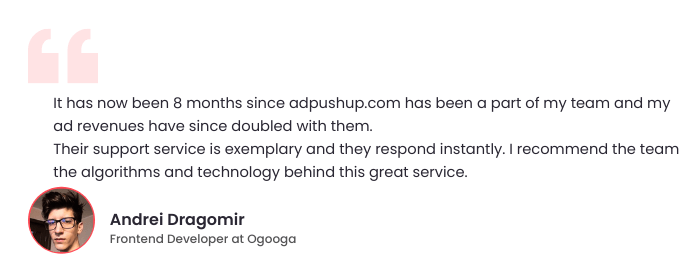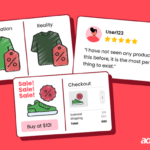Discover the latest ad tech trends set to shape 2025. Check out our blog to see what’s driving change in the industry.
The ad tech industry is like a high-speed rollercoaster – exhilarating, unpredictable, and filled with twists and turns. After a year marked by significant advancements and innovation in 2024, we’re now hurtling toward an even more exciting 2025.
In fact, according to Statista, programmatic advertising was worth 418 billion U.S. dollars in 2021. And this figure is expected to reach 725 billion by 2026.
That said, without further ado, let’s straightaway delve into the ad tech trends and development.
Top Ad Tech Trends to Lookout for in 2025
Here’s how we think the future of ad tech will look in 2025 and beyond:
1. Connected TV (CTV)
CTV consumption and advertising have already cemented their place in the US. Other countries, like India, and China, have also started well on consumer adoption of CTV. The cheaper and easier availability of Smart TVs & dongles (Amazon Fire Stick, Chromecast, etc.), together with compelling content propositions of leading OTT players, is only going to accelerate this change going forward.
As consumers will spend more time on this device and content format, ad dollars will also eventually move in this direction. The USA market is expected to see growth for both subscriber’s SVOD (Subscription Video-on-Demand) content and advertiser-funded AVOD (Advertising Video-on-Demand) content on CTV.
2. Video Ads Adoption
Video’s influence will only grow as brands will continue to leverage its power. As per a study, viewers retain 95% of video information compared to 10% with text, making it a key retention driver.
Social media platforms fueled video consumption last year, prompting brands to adapt their campaigns. Interactive shoppable video ads capitalize on the e-commerce boom.
Contextual video ads offer publishers an alternative to third-party data, while social commerce provides opportunities for video content.
Large brands leverage video ads for brand awareness and education, but understanding audience consumption is crucial for success.

3. Hyper-Personalization
The next ad tech trend in the list is Hyper-Personalization. The hyper-personalization is the game-changer within the ad tech industry. Hyper-personalization means targeting the right user at the right time on the right channel with a personalized contextual message. We see this marketing trend continue, aiding advertisers in providing targeted experiences to consumers through segmenting and smart audience management with the help of technologies including data analytics, AI, and ML.
We believe AI/ML-led contextual ads to drive app and product recommendations have just about started to take off, and this will continue to grow significantly this year and beyond.
Moreover, brands now have the capability to employ machine learning algorithms for real-time analysis of data, providing deeper insights into their market’s user journey. Furthermore, integrating AI and automation into tech simplifies the workflow for professionals, enhancing efficiency.
Learn more: Revolutionizing Human Resources with Artificial Intelligence
4. Geotargeting
Out-of-home (OOH) advertising is making a comeback. However, we are not talking about traditional billboards, as OOH options now have become a lot more sophisticated. Advertisers can use programmatic geolocation signals and blend online & offline usage data to better connect with their audiences on the go.
While the pandemic-led lockdowns impacted this industry negatively in the previous year, we expect 2025 to be the time for it to bounce back, with the growth being driven through greater adoption of programmatic.
5. Augmented Reality and Virtual Reality
The increase in the popularity of Augmented / Virtual Reality is nothing new. However, after the pandemic, there has been a significant acceleration in its use. AR and VR offer a multitude of possibilities for brands to engage with consumers both online & offline, in real-world or virtual, drive branding campaigns, in-store navigation, and innovative online product discovery-cum-trial that mirror a physical shopping experience.
Combined with AI, Mixed Reality (MR), having AR & VR blended together can become an extension of the human senses. Some of the global brands have been early adopters of this technology to open 24×7 Virtual Malls with online shopping experience for one’s virtual avatars or for famous gaming characters, design to testing online models of home decor, and celebrity endorsements without incurring a hefty fee for the celebrity’s physical presence across multiple locations as well as personalized marketing, revolutionizing brand and retail commerce.
6. Integrated Consumer Journeys
Another ad tech trend in the list is integrated consumer journeys. Consumer journeys online and offline have blended, making the ad spend consumer-focused rather than media-focused. The consumer is present across multiple channels and what the advertiser wants is to reach out to the consumer across online & offline channels to drive incremental engagements at the right time, right channel, the right content, and the right price.
Platforms span across the consumer journeys, enabling the advertiser to take a single view of the consumer and engage him/her across multiple touchpoints in both the online and offline space, with online targeting, omnichannel marketing, proximity marketing, and Drive-to-Store campaigns with incremental footfall measurement in real-time.
7. Vernacularisation
Vernacularisation is also making it to the ad tech trends in 2025 as more and more people come online. The percentage of consumers who consume digital content in local languages is increasing every day. The pandemic has also given a huge impetus to the consumption of vernacular content. It has been said for a long that the USA is not one single market but rather a combination of several micro markets. Vernacular content and advertising is a true manifestation of this.
As a result, advertisers are looking to leverage this opportunity to reach the next 100 million new online shoppers who are likely to have a vernacular affinity to better contextualize their ads and improve response rates.
8. Change in Data Privacy
With 2025 set to bring significant changes to the media and marketing landscape, publishers and advertisers need to be ready to do more with less personal data.
Google’s decision to delay removing third-party cookies from Chrome has given both publishers and advertisers time to dive into new opportunities connected to personal data collection.
This year will have to be one of transparency and authenticity, with companies moving to find their unique voice and connecting to relevant audiences.
9. Ads Gamification
Talking about another ad tech trend to watch for in 2025, it’s none other than the gamification of ads. This can turn out to be one of the most engaging and effective advertising strategies that can bring fruitful results to the publishers. You may have also come across such ads while playing games on your smartphone or computer.
10. Resurgence of DOOH
The landscape of Digital Out-of-Home (DOOH) advertising is undergoing rapid evolution. Since the pandemic has long been gone, there’s been a surge in people spending time outdoors. Adopting a data-driven approach to DOOH not only enables interactive outdoor advertising but also demonstrates nearly 100% resistance to ad fraud, providing a secure and effective advertising medium.
11. Widespread First-Party Data Adoption
The advertising industry has long relied on cookies—small data files collected from users—to guide marketing strategies and spending. However, the rise of stricter privacy regulations is disrupting this approach, forcing advertisers to explore new ways to connect with audiences.
In 2025, contextual targeting, is expected to gain traction as adtech companies shift their focus. This method tailors ads based on the content of a webpage or app, rather than relying on personal user data, offering a privacy-friendly alternative for audience targeting.
12. Retail media networks
As per Emarketer, retail media is going to be the biggest of digital advertising’s three big waves. Thus, it’s safe to say that retail media is going to have significant impact in the adtech industry in 2025.
Retail media networks (RMNs) are the advertising platforms that are built by retailers to capitalize on their exclusive shopper data. These networks offer brands diverse ways to reach customers:
- Onsite ads like sponsored products on retailer websites or apps.
- Offsite campaigns spanning social media, connected TV (CTV), and the open web.
- In-store promotions via digital signage and physical touchpoints.
The key advantage of RMNs lies in their ability to provide closed-loop measurement, which ties ad performance directly to purchase data. For brands that align retail media with their TV advertising strategies, the payoff isn’t just better campaign integration but also access to precise metrics that help maximize ROI.
Final Words
In conclusion, 2025 is expected to bring a lot of changes for Ad Tech, marked by innovation and the evolution of new ad tech solutions. The ad tech trends highlighted above provide a roadmap for advertisers and publishers to navigate this dynamic landscape successfully. Embrace these trends to stay ahead, adapt to change, and capitalize on emerging opportunities in the ever-evolving world of advertising technology.
Set up a free demo with us to grow your ad revenue by upto 40%.
Frequently Asked Questions: Ad Tech Trends
In order to serve relevant ads to relevant audiences, advertisers use a variety of tools and technologies, such as demand-side platforms, supply-side platforms, agency trading desks, ad servers, and ad networks.
Adtech refers to software and tools that agencies, brands, publishers, and platforms use to target, deliver, and measure their digital advertising campaigns. Brands and agencies purchase advertising space using ad tech software platforms. Additionally, they help publishers price and sell ad space.

Deepak has a keen eye for detail and a deep understanding of the ad tech landscape. Whether it’s through in-depth articles, thought-provoking insights, or compelling storytelling, he’s dedicated to helping people navigate the complex world of ad tech with the simplicity of his words.









